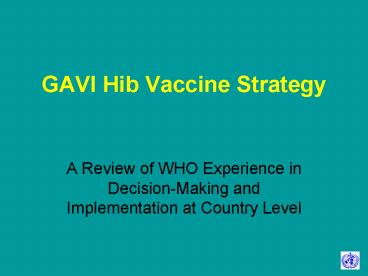GAVI Hib Vaccine Strategy - PowerPoint PPT Presentation
1 / 19
Title:
GAVI Hib Vaccine Strategy
Description:
Hib vaccine introduced, no coverage data reported (26 countries) Hib3 ... Lumbar puncture done? Lab performance? Use of antibiotics? Severity? Blood culture? ... – PowerPoint PPT presentation
Number of Views:63
Avg rating:3.0/5.0
Title: GAVI Hib Vaccine Strategy
1
GAVI Hib Vaccine Strategy
- A Review of WHO Experience in Decision-Making and
Implementation at Country Level
2
Global Coverage with Hib Vaccine1997 2003
1997 (25 countries introduced)
Hib vaccine introduced, no coverage data
reported (25 countries)
Hib vaccine not introduced (167 countries)
2003 (88 countries introduced 46)
Hib3 gt 80 (52 countries)
Hib3 lt 80 (10 countries)
Hib vaccine introduced, no coverage data reported
(26 countries)
Hib vaccine not introduced (104 countries)
Data for 2003 is provisional
Source WHO/UNICEF joint reporting form,
2003 data from 192 WHO member states
3
Main Challenges for Hib Vaccine Introduction
- Decision making
- Is this disease really a problem in my country?
- Is it worth the money spent on it?
- Is it really my highest priority at this time?
- Implementation
- Are the vaccine characteristics suitable for
health workers handling it? - Will I receive enough vaccine to meet my need?
- Will I have enough money in the future to
continue buying this vaccine? - Does this vaccine really make a difference?
The perspective from decision makers in
countries that could benefit from GAVI strategies
will be critical to the development of a
successful agenda
4
Countries Eligible for Hib Vaccine Introduction
5
Burden of Hib Diseases
Lumbar puncture done? Lab performance? Use of
antibiotics?
Unconfirmed Hib meningitis
Estimated Annual Deaths Due to Invasive Hib
infections 200 000 700 000
Severity? Blood culture? Lung aspirate?
Hib Pneumonia
6
(No Transcript)
7
Country-specific incidence, by quartile, of Hib
meningitis per 100 000 children lt 5 years of age
in the pre-vaccine era, 46 countries
Unpublished Studies
Rapid Assessments
Excluding studies of special-risk groups and
those with lt15 cases.
8
- "WHO should assist countries that are considering
the adoption of Hib vaccination () to strengthen
their surveillance and diagnostic capacity for
clinical and laboratory-confirmed meningitis".
- Four possible approaches
- Laboratory-confirmed cases provide
underestimate - RAT needs revised assumptions
- Case-control studies need a link with
population data - Vaccine probes are costly and take time
- SEAR and WPR briefings (August - September 2004)
9
Cost Effectiveness of Hib Vaccination
- Cost per life year saved 17 - 54 000
- (Brinsmead et al. Pediatr Inf Dis J 2004)
- Variable methodologies
- Most studies only include meningitis
- Costing not standardized
- Only 3 published studies from developing
countries (South Africa, Chile, Philippines)
10
Pentavalent VaccineCharacteristics and Supply
- Combination vaccine
- Large storage required
- Liquid-lyophilized
- Price (3.60/dose until 2006)
- Supply
- Single manufacturer
- Demand exceeds availability until 2004
11
Program Costs
One full year between 2001 and 2003
12
Financing of Immunization Programs by Source
Prior to Vaccine Fund support
13
Three Countries Experience
14
Tanzania
- Pre-decisions on Hep B
- Serological data available early 1990s
- Hib rapid assessment (September 2001)
- No cases found in lab records
- Indirect estimation 3300 3450 annual deaths
- Consensus meeting (December 2001)
- Burden of Hib disease not convincing compared to
cost of vaccination - Future
- EPI programme interested in Hib vaccine
- Need to convince senior Ministry officials about
long-term financial sustainability
15
Uganda
- Consensus and introduction
- Initial application for HepB only (October 2000)
- GAVI partners lobby for pentavalent
- Pentavalent vaccine launched by President (June
2002) - Lessons
- 6 months stock-out in 2003 affected public and
political confidence - Internal cost-effectiveness study finds HepB
superior to Hib - Financial sustainability remains the main concern
and country indicated possible discontinuation
16
South Africa
- Pre-decisions and burden data
- HepB introduced in 1995
- Several studies on Hib meningitis and other
invasive infections - Consensus and introduction
- Extensive financial analysis
- Political lobbying at national and provincial
levels - DTP-Hib introduced in June 1999 with open tender
- Factors in favour of introduction
- Clear disease burden data
- Personal conviction of decision-makers
- Impact data from USA, Finland and The Gambia
- Ability to use internal financing resources
17
Lessons from Countries
- Even with demonstrated and convincing disease
burden, this relatively expensive vaccine will
not necessarily be taken / maintained, unless - Supply is sufficient and 100 assured
- Prices will reduce substantially
- Decision-makers are personally interested in
introducing and sustaining this vaccine
18
Summary of Issues
- Collaborate with countries to strengthen
evidence-based decision-making - Burden
- Demonstration in Asia and Eastern Europe
- Awareness in Africa
- Cost-effectiveness
- Consolidate implementation
- Improved product characteristics including
pricing - Increased number of suppliers
- Revised financing strategies
- Impact data assembled and communicated
19
Acknowledgement
- Regional Office for Africa
- Rose Macauley
- Tarande Manzila
- Deo Nshimirimana
- Regional Office for the Americas
- Salvador Garcia
- Jon Andrus
- Regional Office for Eastern Mediterranean
- Ezzedine Mohsni
- Said Youssouf
- Regional Office for Europe
- Andrei Lobanov
- Nedret Emiroglu
- Regional Office for South-East Asia
- Pem Namgyal
- Brent Burkholder
- Regional Office for Western Pacific
- Yang Baoping
- Headquarters
- Marie-Paule Kieny
- Peter Carrasco
- Thomas Cherian
- Jos Vandelaer
- Ulla Griffiths
- Lara Wolfson
- Chris Nelson
- Marta Gacic-Dobo
- Maureen Birmingham
- Miloud Kaddar
- Patrick Lydon
- Lidija Kamara
- Alejandro Costa
- Michel Zaffran
- Oya Afsar
- Tracey Goodman
- Julian Bilous































